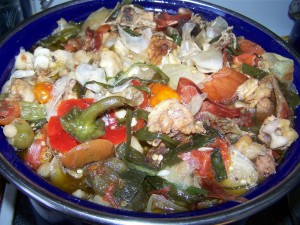I suppose that I ought to put together all my collected kitchen and food storage wisdom in one place – just because. Well, actually, because my daughter came up to me in the grocery store a couple of months ago, asking urgently, “Mom, what was it that you do with ginger root?”
I said, “Peel the root, cut into small chunks, put into a small sealable container covered with sherry, and keep in the refrigerator.” This is what you do, if you are not cooking every day with fresh gingerroot. Let’s face it – most recipes only call for about a teaspoon at a time of fresh gingerroot, and in the grocery store it comes in whole roots considerably bigger than that. So – this is how you will always have fresh gingerroot on hand.
For Hatch chili peppers, and red Bell peppers – buy when in season, or marked down to the lowest price possible. Put them on a baking sheet and on the top rack of your oven, under the broiler. Roast under the broiler, turning when necessary, until the chili peppers are blistering, if not black. Take out of the over, and put an up-ended bowl over them, so they steam for about five minutes. Peel off the tough outer skin, pull out the stem and core – and freeze. Voila – roast red peppers, and roast green peppers for a great deal less than the canned and bottled ones. I spread them out flat in a freezer bag, roll the bag up and seal, so as to be able to extract one at a time.
Since yea on several decades ago, living first in a barracks infested with cockroaches and then in a small off-base apartment with freely-visiting field mice, I have the habit of storing all dry foodstuffs in sealed containers. Large Mason jars, snap-top glass canisters, tins with tight-fitting tops, whatever. It saves a lot of trouble – especially if something comes home from the grocery already infested with weevils or some other insect life. (Putting suspected dry groceries like rice, beans and flour in the freezer for a couple of days is a good way to prevent continued infestation.)
Add a couple of dried bay leaves to rice stored in jars like this. Put a whole vanilla bean into sugar.
There are a couple of different simple gadgets for cutting fresh corn kernels off the whole cob. Use this when fresh corn is at an absolutely rock-bottom price. The taste of fresh-cut corn is sublime.
Quick substitution for buttermilk – half yoghurt and half water.
And finally – following the advice of the very clever and penny-pinching chef whom I read about so long ago, I can’t even remember; keep a special container in the freezer, and whenever you had vegetable scraps, cut ends or clean peelings, or even whole veggies past their best-by date, to throw them into the container. Onion ends, mushroom stems, ends of celery – in fact, everything but broccoli, cabbage and cauliflower scraps could be used. Omit anything spoiled, rotten or moldy, of course. If you are not a vegan, then bones and trimmings from various meats – chicken necks and ham-bones and the like – can be added as well. When the container is completely full, empty the frozen scraps into a large stockpot, and add a handful of fresh parsley (or any other fresh herbs you have available – thyme would be fantastic), some whole peppercorns, and fill with bottled or tap-water up almost to the top of the pot. Cover the stockpot, set it on the stove over low heat, and just let it simmer for a good few days, until all the vegetables are cooked to softness and the broth itself is a rich deep brown.
And that’s it: after a couple of days, allow the pot to cool, and pour the broth off. I like to run it through a fine mesh strainer, and package it in 2-cup to quart quantities for the freezer out in the garage. Nothing makes a better base for soup.


Recent Comments